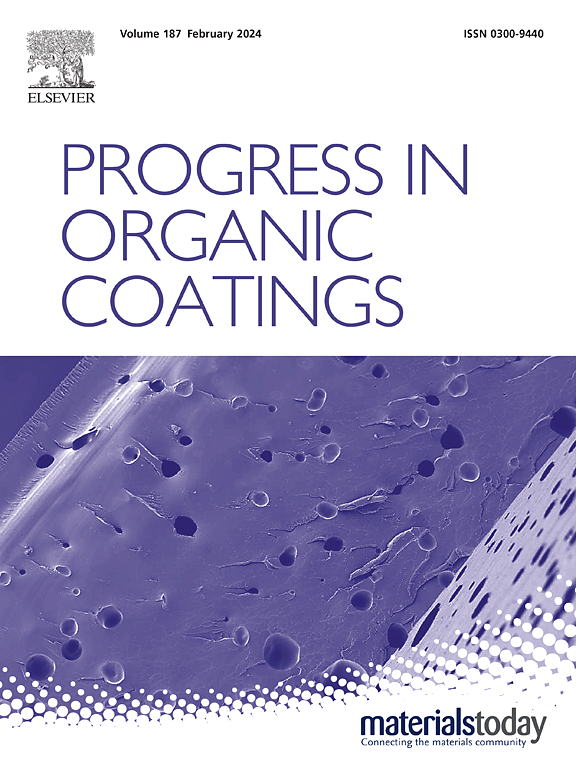多功能和环保聚氨酯涂料由单宁酸的多个方面实现
IF 7.3
2区 材料科学
Q1 CHEMISTRY, APPLIED
引用次数: 0
摘要
开发与基材无关、极其透明和全液体排斥的环保型涂料仍然是一项艰巨的任务。在此,我们提出了一种高度通用的聚氨酯涂料(TA-g-PDMS),它包含植物源性单宁酸(TA)和聚二甲基硅氧烷(PDMS)。高度交联的网络抑制宏观相分离,使所得的TA-g-PDMS涂层具有高达99%的透明度。在最外表面形成的PDMS光滑层既防水又防油,并具有防污和自清洁性能。即使经过500次的重复书写和擦除,涂层仍然保持其优异的防涂鸦性能。由于TA优异的附着力,该涂层可接近5B级附着力,可应用于多种基材。利用TA的抗氧化性能,可以在涂层中原位还原生成纳米银,抗菌率达到99%以上。此外,涂层的自清洁性能加上TA赋予的紫外线屏蔽能力增强了有机太阳能电池(OSCs)的光稳定性和耐久性。我们提出了一种环保的方法来制造多功能和耐用的涂料,用于广泛的用途。本文章由计算机程序翻译,如有差异,请以英文原文为准。

Versatile and environmentally benign polyurethane coatings enabled by the multiple facets of tannic acid
Developing environmentally friendly coatings that are substrate-independent, extremely transparent, and omni-liquid-repellent remains a daunting task. Herein, we present a highly versatile polyurethane coating (TA-g-PDMS) that incorporates plant-derived tannic acid (TA) and polydimethylsiloxane (PDMS). The highly cross-linked network suppresses macroscopic phase separation and endows the resulting TA-g-PDMS coating with up to 99 % transparency. The PDMS smooth layer formed on the outermost surface repels both water and oil, and has anti-smudge and self-cleaning properties. Even after 500 repetitive writing and erasing cycles, the coating still maintains its excellent anti-graffiti properties. Due to the superior adhesion of TA, this coating can approach top 5B adhesion and can be applied to a variety of substrates. By utilizing the antioxidant properties of TA, silver nanoparticles can be generated in the coating by in situ reduction, resulting in an excellent antibacterial rate of more than 99 %. Furthermore, the self-cleaning properties of the coating coupled with the UV shielding ability imparted by TA enhance the photostability and durability of organic solar cells (OSCs). We present an eco-friendly method of fabricating versatile and durable coatings for a wide array of uses.
求助全文
通过发布文献求助,成功后即可免费获取论文全文。
去求助
来源期刊

Progress in Organic Coatings
工程技术-材料科学:膜
CiteScore
11.40
自引率
15.20%
发文量
577
审稿时长
48 days
期刊介绍:
The aim of this international journal is to analyse and publicise the progress and current state of knowledge in the field of organic coatings and related materials. The Editors and the Editorial Board members will solicit both review and research papers from academic and industrial scientists who are actively engaged in research and development or, in the case of review papers, have extensive experience in the subject to be reviewed. Unsolicited manuscripts will be accepted if they meet the journal''s requirements. The journal publishes papers dealing with such subjects as:
• Chemical, physical and technological properties of organic coatings and related materials
• Problems and methods of preparation, manufacture and application of these materials
• Performance, testing and analysis.
 求助内容:
求助内容: 应助结果提醒方式:
应助结果提醒方式:


